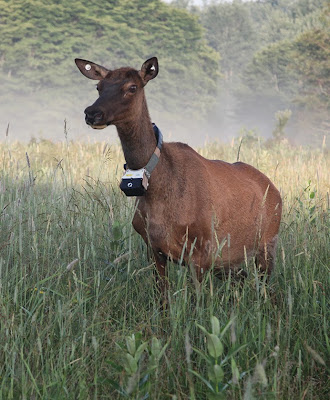Camera to Provide Elk's Point of View
With footage captured by a tiny video camera placed on a Pennsylvania elk this week, researchers soon will find out.
The research initiative is a product of a partnership between the Pennsylvania Game Commission and the Keystone Elk Country Alliance, a Pennsylvania-based nonprofit organization headquartered at the Elk Country Visitor Center in Benezette, Pa.
The Game Commission actively manages wildlife habitat throughout Pennsylvania, and within the state’s 3,500-square-mile elk-management area. Habitat quality directly influences elk pregnancy rates, survival, calf recruitment and the distribution of elk.
Projects to improve or create high-quality habitat also are used to mitigate elk-human conflicts and hunter-related elk mortality. By making lands more inviting to elk, elk aren’t as likely to turn up in less ideal areas.
Traditional studies on the types of habitat elk prefer have provided both biologists and land managers with information needed to create high-quality elk habitat. However, a complete understanding of the elk’s habitat selection requires an examination at the finest scale.
Previously, the Game Commission wasn’t able to collect that information.
But on Tuesday, researchers placed a collar on an adult cow elk that not only will record her locations through GPS technology, but also will record video shot by a camera housed within the collar.
A short video of the collar being placed on the elk is available to view at the Game Commission’s YouTube page, www.youtube.com/pagamecommission.
The camera is programmed to collect video and audio during specific times of the day.
The collar will fall off the elk in about 75 days, at which time the Game Commission will send the collar back to the manufacturer so the recordings can be retrieved. By providing never-before-collected information at the micro-scale, the recordings and readings from the collar will assist biologists and land managers, and will help in the planning and development of habitat-management programs.
The Keystone Elk Country Alliance (KECA) purchased the collar and will use the information collected for educational programming, as well as habitat management.
“High-quality habitat is vitally important to elk, to the Game Commission and to KECA,” said KECA President and CEO Rawley Cogan. “We are pleased to fund this pilot habitat study and we look forward to cooperating with the biologists to refine the habitat-management plan for Pennsylvania’s elk range.”
Pictured, an adult cow elk was fitted Tuesday with a collar that contains GPS tracking capability and a small camera to record video and audio. The collar will fall off the elk in about 75 days, at which time the recordings and readings will be retrieved; researchers on Tuesday place a collar on a cow elk on Pennsylvania’s elk range. Purchased with funds from the Keystone Elk Country Alliance, the collar has GPS tracking capability and contains a camera that will record video and audio. The information will be used by biologists and habitat managers to benefit elk.
Game Commission photos by Hal Korber:




.jpg)

Comments